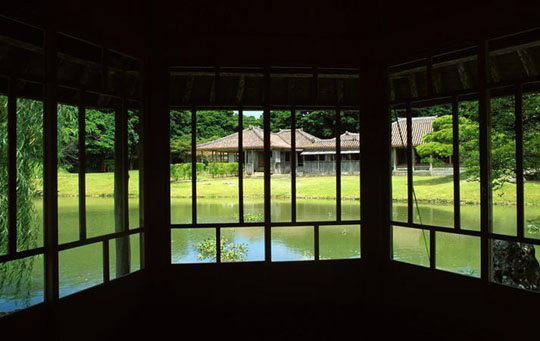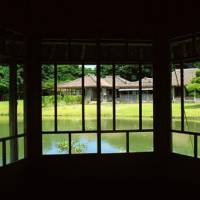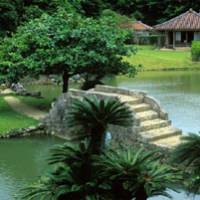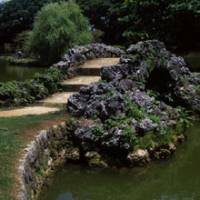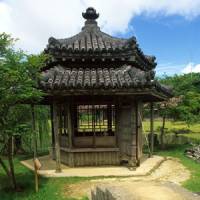The world's first gardens may well have been made of coral, natural clusters of underwater beauty that could be glimpsed through the transparent water. Perfectly tone-coordinated, balanced and formed, they were refined by nature to a degree that may have suggested the divine.
Those living in the coral islands of Okinawa have been well placed to observe these marine gardens, learn from them and requisition their treasures. However, Okinawan garden design and horticulture reflect not only climatic differences, but also disparities in taste and cultural preference from mainland Japan.
Adjoining the wooden, red-tiled buildings and the terraces of Udun Palace, which served as a large second residence for the Ryukyu royal family, Naha's Shikina-en Garden (aka Shichina-Nu- Udun) was completed in 1799.
Soon afterward, when Chinese delegates gathered at the 15-room palace for the coronation of King Sho On of the Ryukyus, the head of one delegation, Cho Bunkai, and his assistant, Lee Teigen, appear to have been the first guests invited to behold the Shikina-en.
The rear parts of Shikina-en resemble a botanical garden, an arboretum with paths set between tightly braided grass. A pavilion at the far rear of the garden has sweeping views of the city outskirts, and it was there the Chinese delegates were taken to demonstrate to them that Okinawa was not a small nor insignificant island.
A nearby grove of banana trees reminds visitors that they are firmly in the subtropics, and that any resemblances to the Japanese stroll garden are minimal.
Continental Asia asserts itself in the Rokkaku-do, a small Chinese-style pavilion of hexagonal design. Constructed as a space to rest and relax, the arched bridge leading to the gazebo is carved from a single piece of Ryukyu limestone. The entire 41,997 sq. meters of the garden was painstakingly reconstructed over a 20-year period after the site was obliterated in World War II.
Looking at prewar photos of the garden, the current restoration is an astonishingly faithful one, right down to the wooden buildings and pavilions. Adding a touch of authenticity to the site, the stone bridges, built in the Chinese style, were largely reconstructed from the remains of the original.
Fortunately, older Okinawans have inordinately good memories. When the grounds were planned for reconstruction, old photographs and records were used alongside the recollections of elderly residents. The restoration of the lower sections of limestone at Ikutoku-sen, a freshwater spring that is the source for the pond, was based on rubbings taken from the original stone blocks. The spring is a fine example of Okinawan masonry work. The stone resetting throughout is skillfully executed, though the pond's cement truss somewhat diminishes the garden's naturalism.
The costly restoration clearly paid off. In 2000, Shikina-en was registered as a UNESCO World Heritage Site, though few people outside Okinawa even seem to be aware of the garden.
Interestingly, at Hokuzan, the most northerly tip of mainland Okinawa, Asumui, a sacred prayer site for shamans and priestesses, is a mysterious looking limestone landscape. A sorcerer's world of sharp, pitted rocks and wobbly paths, it is a fascinating place to visit as it provides insights into some of the geological influences that may have been adopted into Okinawan gardens like Shikina-en.
A fondness for stones, the sharp, spiny rocks of these coral islands, so different from the smooth, moss-covered variety found in Japanese gardens, typifies the Okinawan garden. If rocks represent mountains, in Okinawa they also evoke coastal cliffs and offshore formations. Never far from the sea, these stone arrangements are doubtless modified versions of the complex, interlocking rock piles found in classic Chinese gardens.
The limestone compositions of the Chinese garden consisted of fabulist piles of energizing rocks full of blowholes, scooped surfaces, cavities and hollows — a playful effect still much beloved of the Chinese.
However, the Chinese influence, while important, should not be emphasized at the expense of native Okinawan instincts. Although there was symbolism embedded in the gardens of Okinawan royalty, the adoption of Chinese forms was mostly visual and aesthetic. Complex notions such as the belief among Daoist scholars that a private garden, "simple, formless, desireless, without striving," was an articulation of a yearning for a graceful, happy, long life in retirement, had little place in the exuberant, flower- and plant-filled gardens of these islanders.
Metaphysics have never much appealed to the Okinawan mind. Eschewing the demanding symbolism of the Japanese garden, most Okinawans would feel perfectly comfortable with the simple sentiments of the Ming Era Chinese writer and gardener Wen Zhenheng, when he wrote that gardens ought to be places where the visitor should be able to "forget their age, forget to go home, and forget their fatigue."
ANA and JAL both have daily flights to Naha. Skymark also flies there. The garden can be reached by taxi, a 30-minute walk from Shuri Castle, or by taking Bus 5 from Kokusai-dori, or Bus 14 at Naha Bus Center or Asahibashi Station to the Shikina-en-mae stop. Open 9 a.m.-4.30 p.m., closed Weds. Entrance ¥400 for adults.



